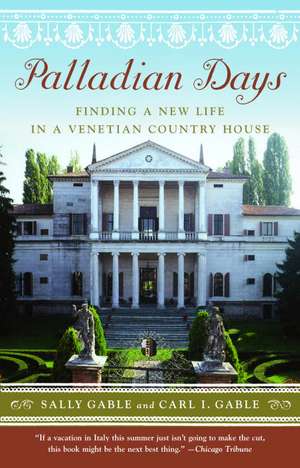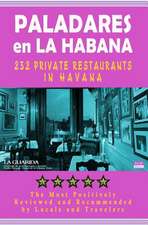Palladian Days: Finding a New Life in a Venetian Country House
Autor Sally Gable, Carl I. Gableen Limba Engleză Paperback – 31 mai 2006
In 1552, in the countryside outside Venice, the great Renaissance architect Andrea Palladio built Villa Cornaro. In 1989, Sally and Carl Gable became its bemused new owners. Called by Town & Country one of the ten most influential buildings in the world, the villa is the centerpiece of the Gables’ enchanting journey into the life of a place that transformed their own. From the villa’s history and its architectural pleasures, to the lives of its former inhabitants, to the charms of the little town that surrounds it, this loving account brings generosity, humor, and a sense of discovery to the story of small-town Italy and its larger national history.
Preț: 103.27 lei
Nou
Puncte Express: 155
Preț estimativ în valută:
19.76€ • 20.67$ • 16.42£
19.76€ • 20.67$ • 16.42£
Carte disponibilă
Livrare economică 12-26 martie
Preluare comenzi: 021 569.72.76
Specificații
ISBN-13: 9781400078738
ISBN-10: 1400078733
Pagini: 266
Ilustrații: 24 PHOTOS & ILL.
Dimensiuni: 135 x 203 x 16 mm
Greutate: 0.27 kg
Editura: Anchor Books
ISBN-10: 1400078733
Pagini: 266
Ilustrații: 24 PHOTOS & ILL.
Dimensiuni: 135 x 203 x 16 mm
Greutate: 0.27 kg
Editura: Anchor Books
Notă biografică
Sally Gable, a church music director by training, has served on the boards of Radcliffe College, the Atlanta Symphony Orchestra, and other educational and musical organizations. Carl I. Gable, a lawyer and businessman and the author of a book on Venetian glass, has served on the boards of the Spoleto Festival USA, the Atlanta Opera, the Michael C. Carlos Museum of Emory University, and the Center for Palladian Studies in America. They divide their time between Atlanta and Villa Cornaro in Italy.
Extras
Chapter 1
Pizza with Palladio
“Signora Sally, tonight we’re going to a celebration of pizza!”
Silvana Miolo’s lilting Italian greets me as I sip my morning espresso on the south portico of Villa Cornaro. The low morning sun splashes shadows of Lombardy poplars across the lawn of the park. Swallows circle and swoop bare inches above the closely mown lawn, scooping insects from the warming air, then spiraling upward to reclaim their nests somewhere above my head. Note to diary: Birds nesting in attic? Investigate.
“Una celebrazione di pizza”? Is that what she said?
Silvana senses my puzzlement and quickly finds an alternative way to frame her news. The event, I learn upon retelling, will be a pizza party.
Silvana is a dervish of energy. Dark eyes, dramatized by thick lashes and wavy black hair, animate her face. She has been friend, Italian teacher, and villa savant since I cautiously drove the twenty miles from the Venice airport two weeks ago for my first spring
at the villa. (“Remember, the lady of a villa is called a villainess,” my husband, Carl, advised me soberly as we kissed good-bye in Atlanta.)
Carl will join me in a few weeks. I am alone for now in the
sixteenth-century villa designed by the architect Andrea Palladio that we have audaciously acquired in the village of Piombino Dese, halfway to the foothills northwest of Venice. Silvana is determined that I not feel lonely; when I arrived from the airport she sent her ten-year-old son Riccardo to keep me company while I unpacked.
Silvana’s improbable plans for the evening have me uneasy because of my own recent introduction to Italian, but I’m heartened to find that I needed only one repetition before understanding what is in store.
Silvana and the other Piombinesi I’ve met speak no English. In fact, they don’t ordinarily speak Italian. Their first language is Venetan (pronounced VEHN-eh-tun), a dialect substantially different in its vocabulary and pronunciation from standard Italian and not readily intelligible to strangers. (Whenever Carl has trouble understanding something said in Italian, he tries to claim that the speaker is actually using Venetan.) Once Carl remarked to local friends over dinner that the occasion was a good opportunity for the two of us to practice our Italian for a whole evening. “Yes,” Ilario agreed, surveying his family around the table, “and it’s a good chance for us to practice our Italian, too!”
In succeeding years English will be taught more widely in the schools of Piombino Dese, and the young people of the town will gain confidence in using it with us, but in our early years no local people of our acquaintance speak it. No one, that is, except Ilario. Ilario Mariotto and I are the same age, but when I was leaving for college, he was boarding a ship for Australia, where he would spend four hot, exhausting years chopping sugarcane in the fields. Ilario can still speak halting English despite twenty-five years of disuse. Note to diary: Where has my college French gone?
Each morning I climb out of bed and assemble my limited Italian verbs and nouns into imaginary dialogues with Silvana, trying to prepare myself for her arrival. At eight o’clock she walks over from Caffè Palladio, the bar and sandwich shop that she and her husband, Giacomo, own and operate across the street from the villa. Her purpose is to open our balcone. Balcone is the Venetan—not Italian—word for shutters. The villa has forty-four immense pairs of them, most of them more than ten feet tall. In accordance with local custom, and for security as well, all of them must be closed and latched each night and opened each morning. Those on the ground floor are secured with a heavy steel bar lifted and fitted into slots on each side of the window opening. For Carl or me, it would be a thirty-minute task every morning and night. Silvana or Giacomo can do it in twenty. (Their older son Leonardo can do it in fifteen minutes, but the process is a cacophony of shutters banging, windows slamming, glass rattling, and steel clanging to wake the dead from their rest in the cemetery of the parish church a block away.) Carl and I refer to it all as the “balcone ceremony”; we quickly come to accept it as part of the rhythm of villa life. Even quicker, however, is Carl’s decision—taken the previous October when we first arrived together as the new owners of Villa Cornaro—that the whole process should be delegated to Giacomo and Silvana in their moonlighting role as custodians of the property.
On my own now in my first spring at the villa, I soon discover the true benefit of the arrangement: Silvana’s morning visits are my gateway to the world of Piombino Dese. She brings me news of the village, listens attentively to my carefully prepared yet nonetheless stumbling forays into Italian conversation, and generally presents mea role model for a donna in Venetan life.
Silvana never loses patience or laughs at my malapropisms. She speaks with slow precision, repeating phrases as often as necessary, rearranging them as bits of a puzzle until the meaning is apparent even to an American novice. My six months of lessons back in Atlanta with Lola Butler, an effervescent military bride from Padua, have drilled me in the basics of Italian grammar. But my brain is not prepared to process a nonstop stream of animated Italian, especially when the conversation turns to septic tanks, sewers, spigots, drains, and other topics that never arose in my dialogues with Lola but grow to fill my life in Piombino Dese.
A pizza party will be a baptism of fire.
Eight cars have arrived ahead of us when we pull into the parking lot at Pizzeria Sombrero that evening, and several others follow. I’m in the dark about the guest list for this outing, but I notice that all those climbing out of the automobiles are women. Each is immaculately dressed in tall heels and a smart suit. Many have bright scarves tossed elegantly across their shoulders with that infuriating insouciance I envy so. We enter a brightly lighted room and take seats at a single long table stretching from one end to the other. About forty women are present—at least thirty-five of them complete strangers to me—and all are in high spirits and chattering rapidly. Silvana lifts her voice to tell me, above the din, that the women in town want to welcome me to Piombino Dese with a pizza party. They are afraid I may be lonely at the villa by myself.
I am afloat in a sea of introductions and mellifluous Italian names: Lucia, Chiara, Emanuela, Pierina, Fiorella, Flora, Elena, Nadia, Enza, Maria Rosa, Luigina, Francesca. Beer is flowing. Pizzas with micro-thin crusts follow in infinite variety. Seafood pizzas arrive topped with mussels and gamberetti—the whole mussels, shells and all! Pizza Maria with creamy white bufala mozzarella and a light sweet tomato sauce. Pizza with pungent arugula. Pizza striped with melanzane(eggplant) and zucchini. Pizza decked with peperoni (not the little salami slices; these are green and red and yellow peppers from the garden). I lose count of the pizzas just as I have already lost track of the names. Perhaps I lose track of the beer as well. But most improbably, I lose my self-consciousness about speaking Italian. My grammar is no better, my vocabulary is no larger, but among friends, what do such things matter? As I wake the next morning, alone in the huge villa, in pitch-black because of the tightly closed balcone, my head slightly disoriented from too much beer, I smile with the realization that I have a new home among the women of Piombino Dese.
Chapter 2
A Home in New Hampshire
As I settle into the pace of Piombino Dese I sometimes wonder—sitting on the south portico in the evening with a glass of prosecco—how Iever managed with the simplicity of only one life, one circle of friends, one language. And I ponder how easily and quickly chance can divert the whole stream of one’s life.
Whatever brought you to buy a Palladian villa in Italy?
It is a question Carl and I never escape. Our Atlanta friends ask, tourists and tour guides ask, occasional magazine writers and television interviewers ask, and from time to time in these quiet moments we ask ourselves. Carl has developed a simple response: “It was a full moon.” I always answer with a longer version, but sometimes I think that I am only telling how it happened, and that I am still searching for the why myself.
In the spring of 1987 I decided that a well-ordered Atlanta family such as ours should have a second home in upstate New Hampshire or possibly Vermont. Although my mother was from Oklahoma and my father from Edinburgh, Scotland, I grew up in Littleton, in the White Mountains of New Hampshire, where my father was a doctor. Since Carl seemed to be weaning himself from working all seven days of the week, I felt the time was ripe for a country retreat, a place where we might, in Thoreau’s phrase, “live deliberately.” Two of our children were in college and the youngest was in high school. I was cheerfully making full-time work of my part-time post as music director of a small church near our home in Atlanta, the result of returning to school for a master’s degree in sacred music. Ashley, Carl, and Jim applauded their mother’s return to academia and found her exam-time anxiety to be a special treat. Still, my plate was not filled; I determined that a vacation house would be a lodestone to draw the family together regularly and to retain familial—or at least friendly—ties through coming decades. Like our black labrador Cleowith a new rawhide bone, I seized the idea and began gnawing away at it.
Visions sprouted in my head: a two-story clapboard cottage on Sugar Hill, or a stone house along the banks of Gale River, its entranceway a spider web of climbing yellow roses. The dreams were vivid in color, scent, and sound, and particular to my native White Mountains.
A ream of National Geodetic Survey maps of northern New Hampshire, each tightly rolled and secured with a rubber band, stood like a bouquet in a corner of our Atlanta bedroom. I’d accumulated the maps through the past ten years and, on visits to my parents, had driven over most of the roads depicted with little squiggly lines. I was often accompanied by my aging garrulous Scottish father, whose legendary love of the mountains and streams of the region translated into exhilarating storytelling with all who chose to listen and some who didn’t. Perhaps we’d find just the home I’d pictured along Skookumchuck Brook running down the north slope of Cannon Mountain, or maybe a perfect bungalow on the narrow ribbon of back road twisting from Littleton to Franconia, where the Presidential Range rests like a purple velvet blanket tossed across the horizon. Or we might spot a cottage on Skinny Ridge Road west of Littleton, where high silver pastures fall away to the midnight blue mirror of Littleton Lake placidly reflecting Mount Misery.
I convinced myself that New Hampshire is easily accessible from Atlanta. A two-and-a-half-hour flight to Boston, a quick stop at the car rental counter, and then—with me driving instead of pokey Carl—just two more hours to our country retreat. Carl was noncommittal when I floated the idea—I took to mean yes. All that remained was forme to find at a bargain price the spot that I had conjured in my mind.
That is my reason one Sunday afternoon in late April 1987, as I sit in our Atlanta living room surrounded by a sea of Brobdingnagian newspapers, for pulling out the Sunday magazine of the New York Times. Rather than launch immediately into the crossword puzzle, I begin to thumb the pages where ads appear for grand houses on Long Island and penthouses in Manhattan, and occasionally for summer houses in New England. I have chosen a bad week for New England summer homes, however; not a single one is listed. In the midst of my disappointment, my eye stops at an unusually unattractive ad from a Greenwich, Connecticut, realtor for a villa in the Veneto region of Italy, a villa allegedly designed by Andrea Palladio, the most influential figure in the history of western architecture.
Frankly, the whole thing seems implausible, but an interesting coincidence nonetheless. The coincidence lies in the fact that Carl and I had made plans several months earlier for a July visit to the Palladian villas in the Veneto. Our friends from London, Judith and Harold, are to meet us there.
With a “Ha!” I show the ad to Carl and tell him that if I don’t find the right spot in New England, we can always settle for our own Palladian villa.
Carl reacts with a disturbing amount of interest. He pulls from our bookshelves the copy of Michelangelo Muraro’s Venetian Villas that we purchased several years earlier, following a three-week family vacation in Florence with a quick side trip to Venice. There is VillaCornaro staring back at us in full color. Villa Cornaro, we discover, is not just a Palladian villa; of the eighteen surviving villas designed by Palladio, it is one of the five largest, best preserved, and most influential in later architecture.
“But, Sally, it’s enormous!” Judith complains two months later after the four of us have climbed from our small, un-air-conditioned rental car parked in Piazzetta Squizzato to stare, dumbstruck at first, across the street at Villa Cornaro. The villa looms above the ancient wall that surrounds it and above Via Roma as well, placid and mysterious as the Sphinx, completely detached from the petty bustle of Piombino Dese on a scorching July day.
“Enormous,” Judith repeats, to emphasize her point. “Beautiful, yes, but very, very big.” Her Israeli accent flavors her words and adds to their authority.
“Mammoth, Carl! You’d need roller skates to get from one end to the other!” Harold’s grin suggests that he would be happy to don the skates.
It’s a palace, I think to myself. Carl keeps his thoughts to himself also.
The gate to the villa is ajar, so we enter to see an elderly couple awaiting us on the north portico. Epifanio Marulli, a gray-haired gentleman with surprisingly bright blue eyes, was custodian of the villa long before Dick Rush, the current owner, arrived on the scene eighteen years earlier, and he has remained as Dick’s custodian as well. Epifanio’s wife, Elena, is with him. From a distance they are dwarfed by the thick, twenty-one-foot-tall Ionic columns rising to support the thinner Corinthian columns of the floor above. They smile shyly, no doubt wondering, as I am, how they will communicate with these strangers who speak no Italian. Harold confided earlier in the morning that he has a little “tourist Italian,” as he calls it, left from vacations his family took when he was a teenager, but Carl and I have taken little comfort in it. “That should be very helpful,” Carl kidded him, “as long as you don’t get confused and ask the custodian for a gondola ride or an antipasto by mistake.”
From the Hardcover edition.
Pizza with Palladio
“Signora Sally, tonight we’re going to a celebration of pizza!”
Silvana Miolo’s lilting Italian greets me as I sip my morning espresso on the south portico of Villa Cornaro. The low morning sun splashes shadows of Lombardy poplars across the lawn of the park. Swallows circle and swoop bare inches above the closely mown lawn, scooping insects from the warming air, then spiraling upward to reclaim their nests somewhere above my head. Note to diary: Birds nesting in attic? Investigate.
“Una celebrazione di pizza”? Is that what she said?
Silvana senses my puzzlement and quickly finds an alternative way to frame her news. The event, I learn upon retelling, will be a pizza party.
Silvana is a dervish of energy. Dark eyes, dramatized by thick lashes and wavy black hair, animate her face. She has been friend, Italian teacher, and villa savant since I cautiously drove the twenty miles from the Venice airport two weeks ago for my first spring
at the villa. (“Remember, the lady of a villa is called a villainess,” my husband, Carl, advised me soberly as we kissed good-bye in Atlanta.)
Carl will join me in a few weeks. I am alone for now in the
sixteenth-century villa designed by the architect Andrea Palladio that we have audaciously acquired in the village of Piombino Dese, halfway to the foothills northwest of Venice. Silvana is determined that I not feel lonely; when I arrived from the airport she sent her ten-year-old son Riccardo to keep me company while I unpacked.
Silvana’s improbable plans for the evening have me uneasy because of my own recent introduction to Italian, but I’m heartened to find that I needed only one repetition before understanding what is in store.
Silvana and the other Piombinesi I’ve met speak no English. In fact, they don’t ordinarily speak Italian. Their first language is Venetan (pronounced VEHN-eh-tun), a dialect substantially different in its vocabulary and pronunciation from standard Italian and not readily intelligible to strangers. (Whenever Carl has trouble understanding something said in Italian, he tries to claim that the speaker is actually using Venetan.) Once Carl remarked to local friends over dinner that the occasion was a good opportunity for the two of us to practice our Italian for a whole evening. “Yes,” Ilario agreed, surveying his family around the table, “and it’s a good chance for us to practice our Italian, too!”
In succeeding years English will be taught more widely in the schools of Piombino Dese, and the young people of the town will gain confidence in using it with us, but in our early years no local people of our acquaintance speak it. No one, that is, except Ilario. Ilario Mariotto and I are the same age, but when I was leaving for college, he was boarding a ship for Australia, where he would spend four hot, exhausting years chopping sugarcane in the fields. Ilario can still speak halting English despite twenty-five years of disuse. Note to diary: Where has my college French gone?
Each morning I climb out of bed and assemble my limited Italian verbs and nouns into imaginary dialogues with Silvana, trying to prepare myself for her arrival. At eight o’clock she walks over from Caffè Palladio, the bar and sandwich shop that she and her husband, Giacomo, own and operate across the street from the villa. Her purpose is to open our balcone. Balcone is the Venetan—not Italian—word for shutters. The villa has forty-four immense pairs of them, most of them more than ten feet tall. In accordance with local custom, and for security as well, all of them must be closed and latched each night and opened each morning. Those on the ground floor are secured with a heavy steel bar lifted and fitted into slots on each side of the window opening. For Carl or me, it would be a thirty-minute task every morning and night. Silvana or Giacomo can do it in twenty. (Their older son Leonardo can do it in fifteen minutes, but the process is a cacophony of shutters banging, windows slamming, glass rattling, and steel clanging to wake the dead from their rest in the cemetery of the parish church a block away.) Carl and I refer to it all as the “balcone ceremony”; we quickly come to accept it as part of the rhythm of villa life. Even quicker, however, is Carl’s decision—taken the previous October when we first arrived together as the new owners of Villa Cornaro—that the whole process should be delegated to Giacomo and Silvana in their moonlighting role as custodians of the property.
On my own now in my first spring at the villa, I soon discover the true benefit of the arrangement: Silvana’s morning visits are my gateway to the world of Piombino Dese. She brings me news of the village, listens attentively to my carefully prepared yet nonetheless stumbling forays into Italian conversation, and generally presents mea role model for a donna in Venetan life.
Silvana never loses patience or laughs at my malapropisms. She speaks with slow precision, repeating phrases as often as necessary, rearranging them as bits of a puzzle until the meaning is apparent even to an American novice. My six months of lessons back in Atlanta with Lola Butler, an effervescent military bride from Padua, have drilled me in the basics of Italian grammar. But my brain is not prepared to process a nonstop stream of animated Italian, especially when the conversation turns to septic tanks, sewers, spigots, drains, and other topics that never arose in my dialogues with Lola but grow to fill my life in Piombino Dese.
A pizza party will be a baptism of fire.
Eight cars have arrived ahead of us when we pull into the parking lot at Pizzeria Sombrero that evening, and several others follow. I’m in the dark about the guest list for this outing, but I notice that all those climbing out of the automobiles are women. Each is immaculately dressed in tall heels and a smart suit. Many have bright scarves tossed elegantly across their shoulders with that infuriating insouciance I envy so. We enter a brightly lighted room and take seats at a single long table stretching from one end to the other. About forty women are present—at least thirty-five of them complete strangers to me—and all are in high spirits and chattering rapidly. Silvana lifts her voice to tell me, above the din, that the women in town want to welcome me to Piombino Dese with a pizza party. They are afraid I may be lonely at the villa by myself.
I am afloat in a sea of introductions and mellifluous Italian names: Lucia, Chiara, Emanuela, Pierina, Fiorella, Flora, Elena, Nadia, Enza, Maria Rosa, Luigina, Francesca. Beer is flowing. Pizzas with micro-thin crusts follow in infinite variety. Seafood pizzas arrive topped with mussels and gamberetti—the whole mussels, shells and all! Pizza Maria with creamy white bufala mozzarella and a light sweet tomato sauce. Pizza with pungent arugula. Pizza striped with melanzane(eggplant) and zucchini. Pizza decked with peperoni (not the little salami slices; these are green and red and yellow peppers from the garden). I lose count of the pizzas just as I have already lost track of the names. Perhaps I lose track of the beer as well. But most improbably, I lose my self-consciousness about speaking Italian. My grammar is no better, my vocabulary is no larger, but among friends, what do such things matter? As I wake the next morning, alone in the huge villa, in pitch-black because of the tightly closed balcone, my head slightly disoriented from too much beer, I smile with the realization that I have a new home among the women of Piombino Dese.
Chapter 2
A Home in New Hampshire
As I settle into the pace of Piombino Dese I sometimes wonder—sitting on the south portico in the evening with a glass of prosecco—how Iever managed with the simplicity of only one life, one circle of friends, one language. And I ponder how easily and quickly chance can divert the whole stream of one’s life.
Whatever brought you to buy a Palladian villa in Italy?
It is a question Carl and I never escape. Our Atlanta friends ask, tourists and tour guides ask, occasional magazine writers and television interviewers ask, and from time to time in these quiet moments we ask ourselves. Carl has developed a simple response: “It was a full moon.” I always answer with a longer version, but sometimes I think that I am only telling how it happened, and that I am still searching for the why myself.
In the spring of 1987 I decided that a well-ordered Atlanta family such as ours should have a second home in upstate New Hampshire or possibly Vermont. Although my mother was from Oklahoma and my father from Edinburgh, Scotland, I grew up in Littleton, in the White Mountains of New Hampshire, where my father was a doctor. Since Carl seemed to be weaning himself from working all seven days of the week, I felt the time was ripe for a country retreat, a place where we might, in Thoreau’s phrase, “live deliberately.” Two of our children were in college and the youngest was in high school. I was cheerfully making full-time work of my part-time post as music director of a small church near our home in Atlanta, the result of returning to school for a master’s degree in sacred music. Ashley, Carl, and Jim applauded their mother’s return to academia and found her exam-time anxiety to be a special treat. Still, my plate was not filled; I determined that a vacation house would be a lodestone to draw the family together regularly and to retain familial—or at least friendly—ties through coming decades. Like our black labrador Cleowith a new rawhide bone, I seized the idea and began gnawing away at it.
Visions sprouted in my head: a two-story clapboard cottage on Sugar Hill, or a stone house along the banks of Gale River, its entranceway a spider web of climbing yellow roses. The dreams were vivid in color, scent, and sound, and particular to my native White Mountains.
A ream of National Geodetic Survey maps of northern New Hampshire, each tightly rolled and secured with a rubber band, stood like a bouquet in a corner of our Atlanta bedroom. I’d accumulated the maps through the past ten years and, on visits to my parents, had driven over most of the roads depicted with little squiggly lines. I was often accompanied by my aging garrulous Scottish father, whose legendary love of the mountains and streams of the region translated into exhilarating storytelling with all who chose to listen and some who didn’t. Perhaps we’d find just the home I’d pictured along Skookumchuck Brook running down the north slope of Cannon Mountain, or maybe a perfect bungalow on the narrow ribbon of back road twisting from Littleton to Franconia, where the Presidential Range rests like a purple velvet blanket tossed across the horizon. Or we might spot a cottage on Skinny Ridge Road west of Littleton, where high silver pastures fall away to the midnight blue mirror of Littleton Lake placidly reflecting Mount Misery.
I convinced myself that New Hampshire is easily accessible from Atlanta. A two-and-a-half-hour flight to Boston, a quick stop at the car rental counter, and then—with me driving instead of pokey Carl—just two more hours to our country retreat. Carl was noncommittal when I floated the idea—I took to mean yes. All that remained was forme to find at a bargain price the spot that I had conjured in my mind.
That is my reason one Sunday afternoon in late April 1987, as I sit in our Atlanta living room surrounded by a sea of Brobdingnagian newspapers, for pulling out the Sunday magazine of the New York Times. Rather than launch immediately into the crossword puzzle, I begin to thumb the pages where ads appear for grand houses on Long Island and penthouses in Manhattan, and occasionally for summer houses in New England. I have chosen a bad week for New England summer homes, however; not a single one is listed. In the midst of my disappointment, my eye stops at an unusually unattractive ad from a Greenwich, Connecticut, realtor for a villa in the Veneto region of Italy, a villa allegedly designed by Andrea Palladio, the most influential figure in the history of western architecture.
Frankly, the whole thing seems implausible, but an interesting coincidence nonetheless. The coincidence lies in the fact that Carl and I had made plans several months earlier for a July visit to the Palladian villas in the Veneto. Our friends from London, Judith and Harold, are to meet us there.
With a “Ha!” I show the ad to Carl and tell him that if I don’t find the right spot in New England, we can always settle for our own Palladian villa.
Carl reacts with a disturbing amount of interest. He pulls from our bookshelves the copy of Michelangelo Muraro’s Venetian Villas that we purchased several years earlier, following a three-week family vacation in Florence with a quick side trip to Venice. There is VillaCornaro staring back at us in full color. Villa Cornaro, we discover, is not just a Palladian villa; of the eighteen surviving villas designed by Palladio, it is one of the five largest, best preserved, and most influential in later architecture.
“But, Sally, it’s enormous!” Judith complains two months later after the four of us have climbed from our small, un-air-conditioned rental car parked in Piazzetta Squizzato to stare, dumbstruck at first, across the street at Villa Cornaro. The villa looms above the ancient wall that surrounds it and above Via Roma as well, placid and mysterious as the Sphinx, completely detached from the petty bustle of Piombino Dese on a scorching July day.
“Enormous,” Judith repeats, to emphasize her point. “Beautiful, yes, but very, very big.” Her Israeli accent flavors her words and adds to their authority.
“Mammoth, Carl! You’d need roller skates to get from one end to the other!” Harold’s grin suggests that he would be happy to don the skates.
It’s a palace, I think to myself. Carl keeps his thoughts to himself also.
The gate to the villa is ajar, so we enter to see an elderly couple awaiting us on the north portico. Epifanio Marulli, a gray-haired gentleman with surprisingly bright blue eyes, was custodian of the villa long before Dick Rush, the current owner, arrived on the scene eighteen years earlier, and he has remained as Dick’s custodian as well. Epifanio’s wife, Elena, is with him. From a distance they are dwarfed by the thick, twenty-one-foot-tall Ionic columns rising to support the thinner Corinthian columns of the floor above. They smile shyly, no doubt wondering, as I am, how they will communicate with these strangers who speak no Italian. Harold confided earlier in the morning that he has a little “tourist Italian,” as he calls it, left from vacations his family took when he was a teenager, but Carl and I have taken little comfort in it. “That should be very helpful,” Carl kidded him, “as long as you don’t get confused and ask the custodian for a gondola ride or an antipasto by mistake.”
From the Hardcover edition.
Recenzii
“If a vacation in Italy this summer just isn’t going to make the cut, this book might be the next best thing.” –Chicago Tribune“Timeless and completely modern. . . . Should be enjoyed while dreaming of the Venetian countryside, a tall glass of Prosecco in hand.” –Forbes FYI“Palladian Days lifts the notion of buying a summer house to dizzying and delightful new heights. Sally and Carl Gable’s fascinating account reads like a fast-paced, marvelously satisfying adventure story.” –John Berendt, author of Midnight in the Garden of Good and Evil and The City of Falling Angels
Descriere
This delightful book for armchair and real travelers alike details the adventures of an American couple whose search for a summer home in New Hampshire ends up in Italy's Veneto region. Illustrations.

















